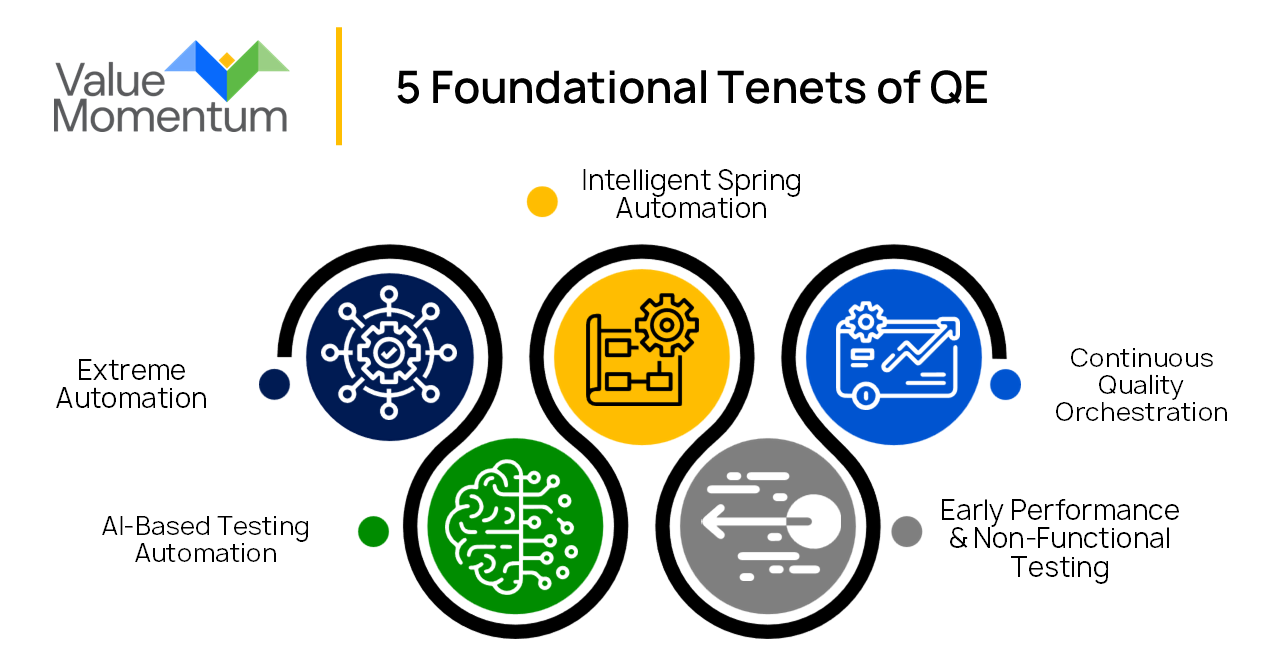Insurers are facing mounting pressure to deliver quality products and services at lightning speed. In fact, in a 2024 survey, consumers ranked mobile app experience as almost as important as brand and reputation, at 35% and 36%, respectively. Customers expect seamless, personalized experiences, and keeping up with these expectations requires insurers to rethink how they approach quality assurance and testing. It’s not just about fixing glitches anymore — insurers need a holistic quality engineering (QE) approach that integrates speed, precision, and innovation.
QE moves beyond traditional testing to deliver a strategy centered on powering growth. By embedding technologies like artificial intelligence (AI) and machine learning (ML) into their QE practices, insurers can accelerate their release cycles, improve efficiency, and ensure every customer interaction is flawless.
More importantly, they can use QE to drive business outcomes, from reducing operational costs to staying ahead in an increasingly competitive market.
How Does QE Drive Business Outcomes?
Traditional testing methods can often be thought of as back-office necessities, but a modern QE approach can be leveraged as a strategic enabler, helping transform testing processes and overall business operations. Here are three key areas where QE practices can help insurers drive their business goals.

Improved Customer Experiences
To meet today’s high customer expectations, insurers must ensure that every digital interaction — from initial quotes to claims — is seamless and responsive. QE supports this by leveraging predictive models, AI, and ML to streamline time-consuming processes such as underwriting and payment handling before they impact the customer experience.
Automated underwriting can cut submission turnaround by half and expedite underwriting decisions by about 40%, providing faster approvals and quicker policy access.
At the same time, QE-driven automation addresses back-office inefficiencies and ensures stable digital platforms across mobile apps, online portals, and agent channels. The result is fewer delays, more personalized services, and a frictionless journey for customers — reinforcing trust, ultimately strengthening brand loyalty, and meeting the evolving demands of the digital insurance landscape.
Operational Efficiency
Achieving robust test coverage can be challenging, as teams often create redundant test cases or leave coverage gaps, both of which slow down testing and increase maintenance overhead. Running regression suites may also become time-consuming due to limited traceability between test cases and requirements.
By incorporating natural language processing (NLP), AI, and ML into an insurer’s QE strategy, IT teams can generate a comprehensive inventory of test cases, gain clear visibility into coverage, and pinpoint where optimization is needed. This results in shorter testing cycles, more targeted test suites, and centralized test repositories that streamline collaboration.
As insurers reduce time to release, lower operational costs, and better allocate resources, they also establish a more stable and predictable environment — one that supports continuous improvement and ultimately enhances the digital experience for customers.
Accelerated Speed to Market
Incomplete test coverage and minimal test automation can delay new releases, preventing insurers from quickly meeting evolving customer expectations. By automating defect triage and using smart regression testing, insurers can rapidly identify issues, optimize coverage, and streamline the entire testing cycle.
NLP-based models analyze incoming defects, map them to the appropriate functional areas, and recommend relevant test scenarios without manual intervention. This early and efficient detection of problems accelerates the speed to market for new features and enhancements.
As these improvements shorten release cycles and reduce defects, customers receive timely access to new capabilities and more reliable digital experiences. Ultimately, this faster, more responsive delivery aligns with customer demands and strengthens the insurer’s position in an increasingly competitive landscape.
How One Insurer Leveraged QE
The organization employed a “transform-while-perform” methodology, and it used a behavior-driven development (BDD) approach to strengthen its test coverage through in-sprint and regression automation.
Conducting a thorough assessment phase helped the insurer identify the appropriate processes for automation as well as determine which automation tools would work with its technology infrastructure. Strong communication across business and IT stakeholders, including project leadership, was vital for the client to be certain that these quality engineering efforts were adequately resourced and that a firm governance model was built into the project from its inception.
By implementing a smart regression tool to execute recommended regression test cases, the insurer was able to reduce its cycle times by about 30%. The QE initiative also resulted in a standardized process that improved operational efficiency, including cutting down on test design time by around 40%, and helped the organization create a metrics dashboard across portfolios to ensure better visibility across the carrier.
Ready to Embark on Your QE Journey?
By embracing QE, insurers can lay the foundation for delivering the seamless digital experiences their customers now expect. Beyond speeding up releases and reducing costs, a mature QE approach drives measurable business outcomes — from accelerating claims processing and improving underwriting accuracy to increasing customer retention through more reliable, personalized services.
In an environment where digital interactions heavily influence customer loyalty, integrating QE into core strategies positions insurers to thrive.
Interested in learning more about how QE can improve your customer experiences? Read our case study, “Large Specialty Insurer Drives UX & Speed to Market with QE Test Automation” to find out how QE can both improve the user experience and accelerate your releases.






